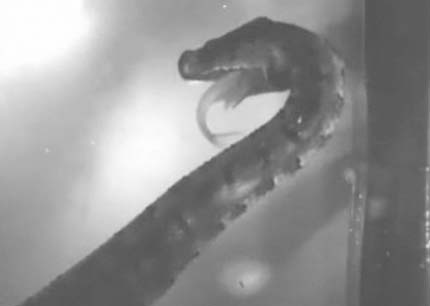Snake Tricks Fish to Swim Into Its Mouth

A small water snake has developed a sneaky trick: It startles fish into swimming right into its mouth.
The tentacled snake, from South East Asia, has the trick so down pat that after scaring the fish, the snake aims and chomps down in a certain location where it knows the fish will soon be. The snake doesn't even have to track its prey.
Scientists used high-speed video to deconstruct the snake's unusual hunting technique.
"I haven't been able to find reports of any other predators that exhibit a similar ability to influence and predict the future behavior of their prey," said Kenneth Catania, associate professor of biological sciences at Vanderbilt University.
Story continues below
{{ video="LS_090619_snakes" title="Snake Tricks Prey" caption="The tentacled snake uses a body fake to trick fish into fleeing toward the snake's head, instead of to safety. Credit: Kenneth Catania, Vanderbilt University" }}
Strange snake
Sign up for the Live Science daily newsletter now
Get the world’s most fascinating discoveries delivered straight to your inbox.
The tentacled snake is the only snake with a pair of short tentacles on its nose. That made Catania curious.
"The snake forms an unusual J shape with its head at the bottom of the J when it is fishing," he explained. "Then it remains completely motionless until a fish swims into the area near the hook of the J. That is when the snake strikes."
The snakes' motions take only a few hundredths of a second — too fast for the human eye to follow. However, its prey reacts even faster, in a few thousandths of a second. In fact, fish are famous for the rapidity of their escape response and it has been extensively studied.
These studies have found that many fish have a special circuit in their brains that initiates the escape, which biologists call the "C-start."
Fish don't have exterior ears as we do, but they have ear parts inside their heads that sense the sound pressure on each side of their body. When the ear on one side detects a disturbance, it sends a message to the fishes' muscles causing its body to bend into a C-shape facing in the opposite direction so it can begin swimming away from danger as quickly as possible.
Catania said he is the first scientist to study this particular predator-prey interaction with the aid of a high-speed video camera. When he began examining the movements of the snake and its prey in slow motion, he saw something peculiar. When the fish turn to flee, most of them turn toward the snake's head and many literally swim into its jaws.
In 120 trials with four different snakes, in fact, he discovered that an amazing 78 percent of the fish turned toward the snake's head instead of turning away.
Even more amazing...
Next, the biologist noticed that the first part of its body that the snake moves is not its head. Instead, it flexes a point midway down its body. Using a sensitive hydrophone that he put in the aquarium, Catania confirmed that this body fake produces sound waves intense enough to trigger the fish's C-start response. Because these sound waves come from the side opposite the snake's head, this reflex action drives the fish to turn and swim directly toward the snake's mouth.
"Once the C-start begins, the fish can't turn back," Catania said. "The snake has found a way to use the fish's escape reflex to its advantage."
As he studied the snake's actions even closer, he made an even more remarkable discovery.
When it strikes, the snake doesn't aim for the fish's initial position and then adjust its direction as the fish moves – the way most predators do. Instead it heads directly for the location where it expects the fish's head to be.
"The best evidence for this is the cases when the snake misses," says Catania. "Not all the targeted fish react with a C-start and the snake almost always misses those that don't react reflexively."
The research, published earlier this month in the Proceedings of the National Academy of Sciences, was supported by a grant from the National Science Foundation.
- Video: See the Tricky Snake in Action
- 7 Shocking Snake Stories
- Snake News, Images & Information










